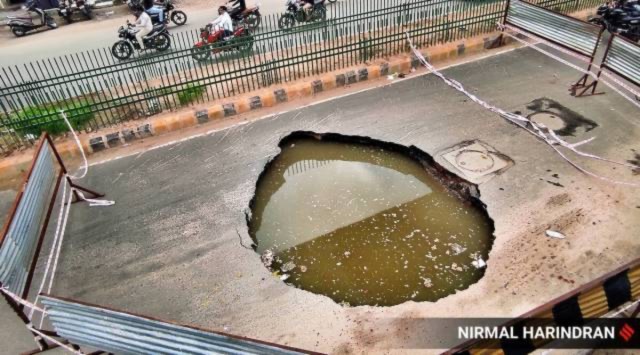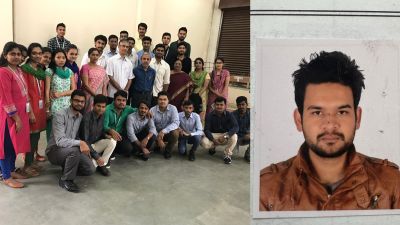Ahmedabad saw 36 road cave-ins during pre-monsoon
According to sources in the drainage department, between May 1 and June 14, the city has seen the roads cave in at 36 places — a steep rise from the 19 reported until June 6, as reported by The Indian Express.
 According to sources in the drainage department, between May 1 and June 14, the city has seen the roads cave in at 36 places — a steep rise from the 19 reported until June 6. (Express Photo by Nirmal Harindran)
According to sources in the drainage department, between May 1 and June 14, the city has seen the roads cave in at 36 places — a steep rise from the 19 reported until June 6. (Express Photo by Nirmal Harindran) Ahmedabad saw nearly 36 instances of road cave-ins during pre-monsoon this year as against one in the same period last year, data from the Ahmedabad Municipal Corporation (AMC) shows. Last year, the city witnessed 98 cave-in incidents in the entire monsoon.
According to sources in the drainage department, between May 1 and June 14, the city has seen the roads cave in at 36 places — a steep rise from the 19 reported until June 6, as reported by The Indian Express.
Amit Patel, Additional City Engineer, who is in charge of maintaining the drainage system, said the civic body “is introducing new technologies for the rehabilitation of the drainage system”. “In the past five to six years, there has been major work in this department. We are gradually doing conditional assessment to find the deteriorated drainage lines and taking them into priority. Some of them have received the tenders, while in other places the work is ongoing,” he said.
To combat the threat of rising number of road cave-ins, AMC is using three main technologies — Cured-in-place pipe (CIPP) technology, Glass reinforced pipe (GRP), and Machine-wound spiral lining (MWSF) — to rehabilitate the deteriorated lines in Ahmedabad. These are preventive measures to prolong the life of the pipes to reduce the number of road cave-ins.
According to Patel, these technologies have already been used in foreign countries for around 20 years. In Ahmedabad, it was introduced around 10 years ago. However, most work in this area was done only in the past four to five years.
The total length of the drainage system in Ahmedabad is more than 3,000 kms. Mostly, rain causes roads to cave-in, but in Ahmedabad, there are factors such as the terrain. “The main reason for road cave-ins in Ahmedabad is because of its sandy strata. Ahmedabad, particularly, has sandy strata but if you compare it to Rajkot, there it is hard rock. Therefore, terrain plays an important role in road cave-ins. Hence, the geographical conditions are also not favourable (in Ahmedabad). If we go to the riverside south, there are even more sandy strata,” Patel said.
During monsoon, the sandy earth filling above the drainage system gains more weight because of percolated water.
“That further increases the dead load and traffic movement builds pressure onto the pipes,” he explained.
AMC cannot dig up roads and replace the pipes as it is an expensive and time-consuming process. However, the AMC has, for public convenience, put out information on the excavated areas on its website listing more than 200 sites that are “excavated” along with the size of the pits, mainly where water or drainage lines are being laid.
Patel also emphasised that some drainage pipes in Ahmedabad are 40-45 years old. “Some in the central zone even belong to the British period,” he added.
According to the official, the aging pipes also pose the risk of “gas attacks and sulphur attacks” that result in corrosion. Moreover, during heavy monsoon, the gushing water creates holes on these pipes weakening the system and leading to road cave-ins.







